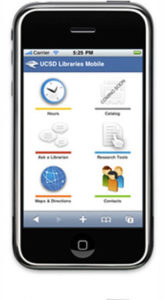
The University of California, San Diego, has joined a small list of schools with library web sites accessible through any smart phone as campus technology leaders try to meet student demand for anytime, anywhere access to library databases.
UC San Diego officials announced the new web site—designed for iPhones, Droids, and other popular smart phones—Sept. 23, highlighting the “Ask a Librarian” feature that lets students chat, text message, or call library staff using the mobile site.
Students also will have easy access to library hours, directions to the building, and a library catalog where they can look for books and other resources and request items to pick up.
And if UC San Diego’s statistics are any indication, students will use the mobile site right away: The non-mobile university library web site receives more than 87,000 hits a day, and about 7,300 people visit the campus’s nine library buildings daily. The network of libraries is home to about 7 million digital and print items and journals, according to the school’s web site.
Daniel Suchy, a user services technology analyst at UC San Diego, said the mobile site’s features were created after research into some of the country’s top campus library web sites accessible via smart phone.
Observing students and faculty members at UC San Diego, Suchy said, made it apparent that a mobile site for the university’s library wouldn’t go to waste.
“It becomes apparent just looking around that everyone is looking at a [smart phone],” he said, adding that the mobile site project started in early June. “It’s just become so commonplace.”
Mobile library sites have been well received on college campuses as the popularity of smart phones has skyrocketed among teenagers and people in their 20s, but a study on the mobile site trend showed that on-the-go library sites are far from universal.
Twenty-four out of 111 members of the Association of Research Libraries (ARL) had mobile web sites for their libraries, according to research published by EDUCAUSE, an organization that advocates for the use of technology in higher education.
Thirty-nine of the 111 colleges and universities included in the study had a mobile web site for the university itself, and only 10 schools have a mobile site for both the campus and its library system.
The most common information found on those mobile sites for campus libraries were hours of operation, library directions, and a library catalog, according to the EDUCAUSE research, conducted by Alan Aldrich, an assistant professor at the University of South Dakota’s College of Arts and Sciences.
Some of the least common features on college library mobile web sites included Google Scholar—just one school had this option—as well as the ability to reserve study rooms, web cameras, and podcasts.
Student surveys at the University of Cambridge in the United Kingdom indicate that UC San Diego’s features could be popular among students with smart phones.
Eight in 10 Cambridge students said they use the university’s mobile site to check library hours, and more than half said they accessed the library catalog through their smart phone. About one-quarter of student respondents said they use the mobile site to read digital journal articles in Cambridge’s library database.
Students’ use of mobile library sites could change with new generations of smart phones that have greater internet capabilities, the research suggests.
The Cambridge study found that limited use of some mobile web functions was because “users [had] first-generation smart phones with limited display screens, the high cost of smart-phone data plans, and the fact that iPhones, Androids, and other larger-screen smart phones were relatively new to the British market at that time,” according to the study.
A national survey of 500 students nationwide conducted by a researcher at Ball State University in Muncie, Ind., showed that smart-phone usage among college students increased from 27 percent in February 2009 to 48 percent in July 2010.
Nine of 10 students who own a smart phone use the device to access the internet, according to the Ball State survey, conducted by journalism professor Michael Hanley, director of the university’s Institute for Mobile Media Research.
Hanley said the growing embrace of mobile devices on college campuses could create enormous demand for web-enabled eReaders like the Apple iPad, a device already used on campuses across the country just five months after its release.
“In the next few years, I see smart phones saturating the collegiate market, but at the same time, devices similar to the iPad will become increasingly popular among young people,” he said.
Smart phones have become students’ “core mobile communication and entertainment device,” Hanley added.
- Research: Social media has negative impact on academic performance - April 2, 2020
- Number 1: Social media has negative impact on academic performance - December 31, 2014
- 6 reasons campus networks must change - September 30, 2014

